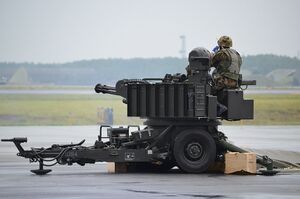TA-78: Difference between revisions
No edit summary |
(→Design) |
||
| Line 7: | Line 7: | ||
The TA-78 consists of a 20mm cannon, linked ammunition feed system, and a fire control system in powered turret, mounted on a towed carriage. | The TA-78 consists of a 20mm cannon, linked ammunition feed system, and a fire control system in powered turret, mounted on a towed carriage. | ||
The carriage is stabilized by two outriggers at the rear and a jack at the front. A single operator is seated on the weapon with the ammunition to his left, the sights and gun in front and a range only radar to his right. More recent upgrades to the system involve the addition of thermal imaging sensors. | The carriage is stabilized by two outriggers at the rear and a jack at the front. A single operator is seated on the weapon with the ammunition to his left, the sights and gun in front and a range only radar to his right. That operator is often supported by an observer, who sits to the, just behind the radar. More recent upgrades to the system involve the addition of thermal imaging sensors. | ||
[[Category:Astyria]][[Category:Blackhelm Confederacy]] | [[Category:Astyria]][[Category:Blackhelm Confederacy]] | ||
Revision as of 16:55, 3 January 2024
The TA-78 is a towed anti-aircraft gun armed with a six barrel 20mm minigun. It entered service in 1978 and is in use with several nations in Astyria.
In addition to its role as an anti-aircraft platform, the TA-78 has also been highly effective against lightly armored vehicles as well.
Design
The TA-78 consists of a 20mm cannon, linked ammunition feed system, and a fire control system in powered turret, mounted on a towed carriage.
The carriage is stabilized by two outriggers at the rear and a jack at the front. A single operator is seated on the weapon with the ammunition to his left, the sights and gun in front and a range only radar to his right. That operator is often supported by an observer, who sits to the, just behind the radar. More recent upgrades to the system involve the addition of thermal imaging sensors.
